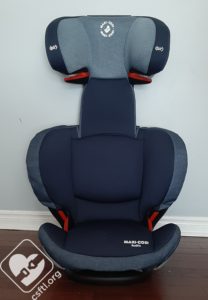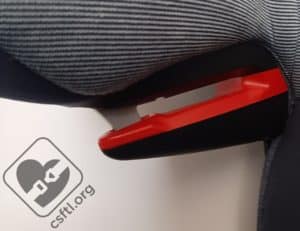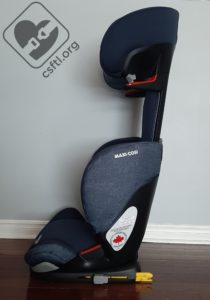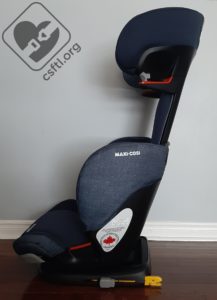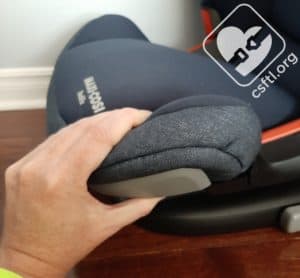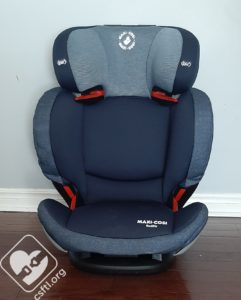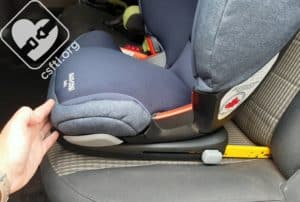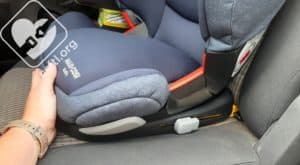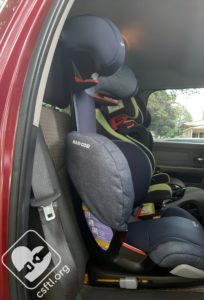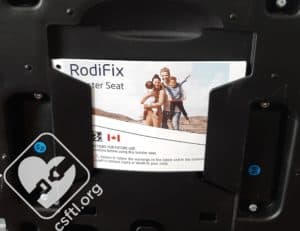The Maxi-Cosi Rodifix has been a solid high back booster seat option in the United States for many years (and has also sat safely on our recommended seats list during that time). Maxi-Cosi has now released the Rodifix into the Canadian market, so we are taking the opportunity to look at it with fresh eyes and new models. This review applies to both North American versions of this seat. Let’s see what it has to offer!
CSFTL Quick Stats
- Weight range: 40-120 pounds
- Height range: 40-57 inches
- Age: no age minimum. CSFTL advocates that children be at least 5 years old before using a booster seat
- Expiration: 10 years from date of manufacture
- Requires replacement after a moderate or severe crash
Measurements
- Width at widest point of back when in narrowest setting: 18.5 inches
- Width at widest point of back when in widest setting: 21 inches
- Width at widest point of base: 17 inches at the front
- Width at lap belt path: 12 inches
- Weight: 13.5 pounds
- Internal width at the child’s hips: 10 inches
- Internal width at the child’s knees: 16 inches
- Seat pan depth: 12 inches
- Lowest shoulder belt guide: 14inches
- Highest shoulder belt guide: 22 inches
Features/Important Information
- Rigid lower anchors (yellow!)
- Shoulder belt positioning guide that “locks” the shoulder belt in
- Narrow lap belt path (for easy buckling)
- Recline adjuster
Manual Recommendations
Because the manual is the ultimate source for information about any given seat, we love when the manuals are thorough.
The Maxi-Cosi Rodifix manual touches on rear and forward facing even though it is a dedicated booster seat. From the manual:
“Infants and Toddlers: Should ride in a rear-facing car seat as long as possible, until they reach the highest weight or height allowed by their seat.
Toddlers and Preschoolers: Once they are forward-facing, children should use a forward-facing car seat with a harness for as long as possible, until they reach the height and weight limits for their seats.
School-Aged Children: Once they have outgrown their forward-facing car seat, children should use a belt-positioning booster seat until the vehicle’s lap and shoulder belt fits properly. This is often when they have reached at least 4 feet 9 inches in height and are 8 to 12 years old.
Older Children: All children younger than 13 should be restrained in the rear seats of vehicles for ultimate protection.”
We applaud Maxi-Cosi for including information for riding safely at all ages and stages. This is excellent information for the reader and is included on pages 2 and 3 of the manual.
Assembly
The Maxi-Cosi Rodifix comes fully assembled – no work needed! Simply unbox the seat, read the manual, and go forth!
Vehicle Headrest
The Maxi-Cosi Rodifix does not allow the vehicle headrest to interfere with a flush booster seat fit in the vehicle. If the vehicle’s headrest cannot be removed or re-positioned to allow the Rodifix to fit the vehicle seat back without a gap, the seat may be incompatible in that seating position. If the gap is small, reach out to Maxi-Cosi’s customer service, as it may be an acceptable installation to them.
Vehicle Support to the Top of the Child’s ears Required
Despite allowing the removal of the vehicle headrest to help with vehicle fit, Maxi-Cosi requires the child to have vehicle seat back/head rest support to the tops of their ears at all times in the Rodifix. This means that in some vehicles, the Rodifix will unfortunately not be a long term solution.
Shoulder Belt Guide
The Maxi-Cosi Rodifix shoulder belt guides are a little different than the guides found on many booster seats, so we wanted to highlight them. If you’ve had the opportunity to test multiple booster seats (like we have), you’ll know that sometimes the shoulder belt is able to slip out of the shoulder belt guide on certain booster seats.
Maxi-Cosi has solved that issue with the Rodifix by having a “lock” on the belt guide that keeps the shoulder belt in the guide at all times. The lock is easily pushed in when threading the belt through the guide, and requires an outside force to push it in to remove the seat belt. This setup creates the “locking” function.
Note: The manual mentions multiple times that the shoulder belt guide is optional and only needs to be used if necessary to position the shoulder belt correctly on the child. We didn’t come across any scenario where the shoulder belt guide wasn’t necessary but if that scenario arises it’s good to know that the guide is optional.
Recline Adjustment
The Maxi-Cosi Rodifix has a few recline settings. These settings are only to be used to install the booster seat flush against the vehicle seat back. The recline angle cannot be adjusted for comfort or preference, just for installation.
To recline the entire seat: squeeze the recline buttons on the sides of the booster seat base and pull out on the bottom of the booster seat.
To make the recline angle more upright, push on the booster seat.
To recline the seat back only, grab the top of the booster seat back and pull back. You will hear a “click” when the position changes.
Adjusting Side Wings — Width
While making this adjustment doesn’t provide a huge increase or decrease in seating area, the Maxi-Cosi Rodifix does adjust to two different widths. These settings don’t include any use restrictions. To adjust the width: hold the side wings and push them out (or in) until they lock into position with a “click”.
Adjusting the Headrest and Shoulder Belt Guide
The Maxi-Cosi Rodifix uses a button on the top of the headrest to help adjust the headrest (and shoulder belt guide height) up and down. Squeeze the button and slide the headrest up or down until it’s in the correct position.
Rigid Lower Anchors
The Maxi-Cosi Rodifix features (yellow!) rigid lower anchors. Because they are rigid, they are set at a fixed width. Translation: the lower anchors can only be used when the seating position features lower anchors with standard (11 inch) spacing.
To install with lower anchors, squeeze the buttons on the outside of the lower anchors adjusters on both sides of the seat and extend the lower anchors out of the Rodifix’s shell.
Place the booster seat on the vehicle seat and align the lower anchor connectors with the vehicle’s lower anchor bars. Push the booster seat back against the vehicle seat back, ensuring that the lower anchors have connected to the anchors in the vehicle. Ta da! The seat is now installed (wasn’t that easy?).
Note: page 9 of the manual warns not to use the lower anchors if the following are true:
- the vehicle seat belt or seat belt buckle is not easily accessible when the booster seat secured with the lower anchors
- The vehicle seat belt or seat belt buckle is between the lower anchors
- The lower anchor connectors are located above the seat bight
Fit to Child
High Back Booster Mode
Because we are writing this review amid a pandemic, our models are limited to only my children, but we will try to be as thorough as possible in this section.
6 Year Old
Our 6 year old model is 52 inches tall and weighs 56 pounds (she has done quite a bit of growing this past year!). She had been riding in a booster seat full time for almost a year, and has had the opportunity to test out many boosters for our reviews.
She often rides in a 3 across setup with her siblings in a 2012 Dodge Ram. Even though the truck is wide and accommodates the three seats fairly easily, buckling a booster seat is not always an easy task.
The Maxi-Cosi Rodifix made buckling a MUCH less painful task for both our model and her family in the Ram because she was able to easily fit her hand between the seats to buckle and unbuckle thanks to the Rodifix’s narrow lap belt path.
She took a few cat naps in the Rodifix and we loved how she was able to stay upright and in position. The seat belt fits her perfectly when she’s both awake and asleep – the lap belt is low on her hips, touching her thighs, and the shoulder belt is centered on her shoulder.
8 Year Old
Our 8 year old model is 56 inches tall and weighs 80 pounds. Probably because he has been a CSFTL model since he was in a harness, this model prefers a high back booster over a backless booster seat for the support, so we were more than happy to be able to add another booster to the list of boosters that can still accommodate his size 10/12 torso.
Here we see him in the Rodifix with the headrest in the 2nd highest position (yes – it gets taller!). Like his sister, the vehicle seat belt fits him perfectly – lap belt is low on his hips, touching his thighs and the shoulder belt is centered on his shoulder.
We extended the headrest to the highest position to show that the Maxi-Cosi Rodifix will likely accommodate him for another year (or possibly even two), which may just get this kiddo to the point where he passes the 5 step test. At 4 feet, 8 inches tall, he is very close to that magical height where children can sit and fit safely in the vehicle using just the adult seat belt.
Fit to Vehicle
The pandemic limited our access to additional vehicles, but we did put the Rodifix through the paces in the vehicles available to us:
2012 Dodge Ram
We reached out to Maxi-Cosi about the installation in our 2012 Dodge Ram because we weren’t sure if this installation would be acceptable or not, since the manual prohibits vehicle headrest interference.
After we shared a video, it was determined that since the back of the Rodifix is making full contact with the vehicle seat, this installation is acceptable.
We were very thankful for that because the Rodifix makes buckling in our 3 across setup MUCH easier. This means there is far less whining whenever we need to go somewhere!.
Important Information: Where to Find
FAA Approval: Like all booster seats, the Maxi-Cosi Rodifix requires a lap/shoulder belt to use, so it is not FAA approved for use on aircraft.
Expiration: Page 20 of the manual indicates that the Rodifix has a 10 year useful life. The date of manufacture is also listed on a lable on the side of the seat’s shell.
Manual Storage: The Rodifix manual stores in the underside of the seat.
Date of Manufacture (and National Safety Mark for Canadian users): The Date of Manufacture label (and National Safety Mark for Canadian users) is located on the side of the Rodifx’s shell.
Overall Thoughts
While booster seats that are only high back boosters and do not convert to backless are few and far between, the Maxi-Cosi Rodifix is an excellent option for a high back booster seat that will accommodate most children until they are able to safely ride in the vehicle without a booster seat. The MSRP is higher than many high back boosters available in the United States and Canada, but the features may make the price point worth it for many families.
The rigid lower anchors make installation a breeze, and the narrow belt path helps even younger (at least 5 years old) booster riders be able to independently buckle and unbuckle themselves.
The ability to reuse the booster seat after a minor collision is another point that caregivers may want to consider when purchasing a booster seat.
While the seat itself may prove to be too wide for many three across scenarios, when width isn’t an issue this booster seat is a excellent option for most (if not all) kiddos.
All in all, the Rodifix’s only downside is that it may be incompatible in vehicles with forward-leaning headrests that cannot be removed. In most other vehicles, though, the Maxi-Cosi Rodifix is definitely a booster seat to consider, provided the child will have vehicle seat back/head rest support to the tops of their ears (ideally with growing room).
Our friends at Maxi-Cosi are giving away a Maxi-Cosi Rodifix to one lucky reader in both Canada and the US! Enter the giveaway here:

